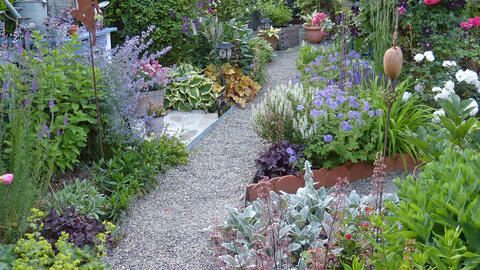Small 1x1 of garden design
Is your garden missing that certain something? Don't be satisfied with standard solutions, but dare to create a distinctive design. With pro tips from the landscape gardener about garden planning, you can give your little paradise more flair.

Not every garden needs a rectangular lawn - in small gardens, flower beds and water-bound paths are usually the better solution
When planning a new garden or part of a garden, the following applies in particular: In the beginning, do not get lost in details and avoid the most common mistakes in garden design. First, divide the plot of land with trees and large shrubs as well as groups of smaller shrubs and create the framework for your garden. With a few little tricks you can easily turn an ordinary garden into your very own personal green living room.
A garden looks particularly beautiful when it forms a harmonious unit with the house. A coordinated choice of materials for the house facade, terrace and paths is an important step for a harmonious impression. A green shroud of climbing plants for the house wall, for example formed from wild grapevine, and shrub beds that extend to the house, ensure smooth transitions between house and garden. At the same time, a flower bed with more shrubs and flowering bushes offers a decorative privacy screen for the patio. Plant the bed in such a way that new visual delights appear in the flower beds with plants that bloom at different times. Because, not only from the terrace, but also from the living room, your gaze will keep going to the plants.
Lay out your garden in such a way that you cannot see everything at one glance. An additional small seat, for example, looks much more attractive if it is only discovered while walking through the garden. A hidden pavilion or a summer house behind a hedge of shrub roses and tall perennials is more dramatic than a free-standing object on the lawn. A curved path invites you to take a stroll through the garden. Plant taller perennials or shrubs at a bend in the path, which block the view of the further course of the path and arouse curiosity about what is hidden behind. Eye-catchers along the way, for example a water feature, a figure or a strongly scented rose, increase the desire for a tour of discovery.

Since trees give the garden spatial depth, you should always plant one, even on a small plot of land. When planning, always work your way from the big picture to the last detail: First, choose the location for the tree and the largest shrubs. If possible, also take into account the growth in size that can be expected for the various species in the coming years. Then the smaller shrubs are planted to subdivide the bedding areas. Finally, dwarf trees and shrubs should be planted in flower beds.
Especially a long, narrow piece of land is a challenge: So that the row house garden does not appear monotonous, it should be divided into garden spaces of different sizes. It doesn't always have to be cut hedges, tall shrubs or trellises that divide the garden. Great effects can be achieved without much effort by just creating a visual subdivision, for example with narrow paving strips in the lawn. A change in shape from the square to the round lawn is also a clever idea that gives the garden character. And a change of material, for example from the lawn to the gravel area, emphasizes the transition from one garden area to the next.

A cozy patio is a must in any garden. An additional seat, on the other hand, is not a must. Such a seat, which does not have to be large, opens up a completely new view of the garden and thus enhances your quality of the experience. To ensure comfortable seating, make sure you have a “back rest”: A trellis with roses and clematis behind the bench creates a protective atmosphere. An evergreen pruned hedge is also ideal. Those who like it more colorful choose flowering shrubs combined with tall shrubs and summer flowers.


